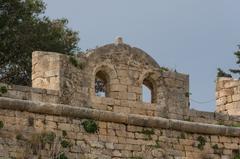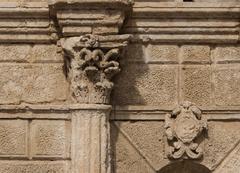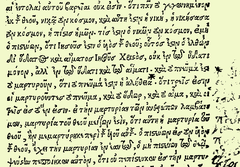Visiting Hours and Tickets for Fragma Potamon, Rethymno, Greece
Published Date: 23/07/2024
Introduction to Fragma Potamon
Welcome to Φράγμα Ποταμών, also known as Potamon Dam, a stunning marvel of engineering nestled in the picturesque region of Rethymno, Crete, Greece. This comprehensive guide will delve into the historical significance, engineering brilliance, economic and environmental impacts, and visitor information essential for anyone planning to explore this incredible site. Constructed to alleviate water shortages in the late 1990s and completed in 2008, the Potamon Dam stands as a testament to regional progress and innovation. The dam’s location on the Geropotamos River in the Amari Valley not only supports local agriculture and drinking water needs but also acts as a key flood control mechanism. This guide will provide insights into the diverse activities available at the dam, from hiking and bird-watching to fishing and educational tours, ensuring a memorable and enriching experience for all visitors. Whether you’re a nature enthusiast, history buff, or simply seeking a serene escape, the Potamon Dam offers a unique blend of natural beauty, cultural richness, and engineering prowess. (Rethymno tourism website)
Contents at a Glance
- Introduction
- Historical Background
- Engineering and Construction
- Environmental and Economic Impact
- Cultural and Social Significance
- Visitor Information
- Ticket Prices
- Opening Hours
- Guided Tours
- Travel Tips
- Future Prospects and Challenges
- FAQ
- Conclusion
Visiting Potamon Dam in Rethymno, Greece - History, Significance, and Visitor Information
Historical Background
The Φράγμα Ποταμών, or Potamon Dam, is a significant infrastructure project located in the region of Rethymno on the island of Crete, Greece. Constructed to address chronic water shortages, particularly during the dry summer months, the project was initiated in the late 1990s and completed in 2008. The dam is situated in the Amari Valley, harnessing the waters of the Geropotamos River. This collaborative effort between local authorities and the Greek government was also funded by the European Union. The primary objective was to create a reliable water reservoir to support agricultural activities, provide drinking water, and contribute to flood control.
Engineering and Construction
The Potamon Dam is an earth-fill embankment dam, a type of dam that uses natural materials such as earth and rock to create a barrier. Standing at a height of 55 meters and stretching 300 meters in length, the dam creates Lake Potamon, a reservoir with a capacity of approximately 23 million cubic meters of water. Advanced engineering techniques were employed to ensure the dam’s stability in a seismically active region, including the use of impermeable clay cores and rockfill shells. The dam also features a spillway designed to handle excess water during periods of heavy rainfall, ensuring the safety and integrity of the structure.
Environmental and Economic Impact
The Potamon Dam has had a profound impact on the local environment and economy. One of the primary benefits has been the stabilization of the water supply for agricultural purposes, allowing the Amari Valley’s fertile land to support a wider variety of crops, including olives, citrus fruits, and vegetables. This has significantly contributed to the local economy. The dam also provides drinking water to several towns and villages in the Rethymno region, improving residents’ quality of life and reducing the incidence of waterborne diseases. Environmentally, the creation of Lake Potamon has led to the development of a new ecosystem, attracting various species of fish, birds, and other wildlife.
Cultural and Social Significance
The Potamon Dam holds cultural and social significance for the local communities. It symbolizes progress and development, reflecting the region’s ability to adapt and thrive. The dam has also become a focal point for community activities and events, fostering a sense of community and shared identity. Additionally, the dam and its surroundings have become a popular tourist destination, offering opportunities for recreational activities such as hiking, bird watching, and fishing. The development of tourism infrastructure around the lake has provided an additional source of income for local businesses and residents.
Visitor Information
Ticket Prices
Visiting the Potamon Dam and its surrounding areas is free of charge, making it an accessible destination for all.
Opening Hours
The area around Potamon Dam is open to visitors year-round, typically from sunrise to sunset. However, it is advisable to check for any seasonal variations or maintenance closures.
Guided Tours
Guided tours are available and provide a comprehensive understanding of the dam’s history, engineering, and environmental significance. These tours can be booked through local tour operators or at the visitor center.
Travel Tips
- Accessibility: The Potamon Dam area is accessible by car, with ample parking available. Public transportation options are limited, so renting a car or joining a tour is recommended.
- Nearby Attractions: While visiting the Potamon Dam, consider exploring other nearby historical sites in Rethymno, such as the Arkadi Monastery and the ancient city of Eleutherna.
- Best Time to Visit: The best time to visit is during the spring and autumn months when the weather is mild, and the landscape is lush and green.
Future Prospects and Challenges
Looking ahead, the Potamon Dam faces several challenges and opportunities. Ongoing maintenance and monitoring are essential to ensure the dam’s safety and functionality, especially given the region’s seismic activity. Additionally, climate change poses a threat to the water levels in the reservoir, potentially impacting water availability and ecosystem health. Efforts are being made to address these challenges through sustainable management practices, including promoting water conservation, enhancing the ecological health of the reservoir, and supporting reforestation projects.
FAQ
What are the visiting hours for Potamon Dam? The Potamon Dam area is open year-round from sunrise to sunset. Check for any seasonal variations or maintenance closures before planning your visit.
How do I get tickets for Potamon Dam? Visiting the Potamon Dam is free of charge. Guided tours can be booked through local tour operators or at the visitor center.
Are there any guided tours available? Yes, guided tours are available and provide detailed insights into the dam’s history, engineering, and environmental impact. These tours can be arranged through local tour operators or at the visitor center.
Call to Action
Plan your visit to the Potamon Dam today and experience the blend of history, engineering, and natural beauty that this remarkable site offers. For more information, download our mobile app, check out other related posts, and follow us on social media for updates and travel tips.
Summary and Final Tips
In conclusion, Φράγμα Ποταμών is not just an engineering marvel but also a symbol of resilience and progress for the Rethymno region. From its historical inception to its present-day significance, the Potamon Dam serves multiple purposes—alleviating water shortages, supporting agriculture, and providing recreational opportunities. The dam has had a transformative impact on the local environment, economy, and community, fostering a sense of pride and unity among residents. As you plan your visit, you’ll find an array of activities to engage in, from hiking and bird-watching to fishing and educational tours. Remember to check for seasonal variations in visiting hours and consider exploring nearby historical sites like the Arkadi Monastery and the ancient city of Eleutherna. By adhering to sustainable tourism practices, you can contribute to the preservation of this beautiful site for future generations to enjoy. We encourage you to download our mobile app Audiala for more tips and updates and follow us on social media for the latest news and travel inspiration. (Rethymno tourism website)


